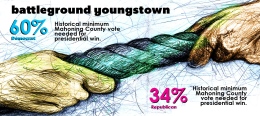
Youngstown sees its share of politicians during the election cycle, and a review of election data reveals that Mahoning County holds a wider importance.
A county-by-county election results map reveals that since 1960, with the exception of 1992 where independent Ross Perot had an unusually strong run, no Democratic nominee for president has won Ohio, and ultimately the presidency, without pulling at least 60 percent of the vote in Mahoning County and 58 percent in Trumbull County.
In contrast, during the same period, Republicans have carried the state to a presidential victory with as little as 34 percent of the vote in Mahoning County and 36 percent in Trumbull County.
Since 1896, the winner of Ohio’s electoral votes has also won general election with only two exceptions. And no Republican candidate has won the general election without also winning Ohio.
The strategy for the White House functions out to an equation of electoral votes in a few key states and a few select areas within those states. In this calculus, the weight of Youngstown and its surrounding area could tip Ohio for or against a candidate.
“Outside of Youngstown, Columbus and the area around Cincinnati, the state is mostly red,” said Paul Sracic, chairman of Youngstown State University’s political science department.
By the numbers, Ohio is a critical swing state with 18 Electoral College votes, the second largest amount after Florida. Because of the area’s population and the way electoral votes are awarded, both Barack Obama and Mitt Romney must perform well in the Youngstown-Warren area.
“The Democrats need Ohio to win and need to perform very well in this area to do so,” Sracic said.
Sracic revealed that each party’s candidate has strengths and weaknesses that may or may not provide victory in the Mahoning Valley.
“What’s more important: social issues or economic issues?” Sracic said. These two categories of voter interests place each party in a position of relative weakness and strength.
For the most part, Democrats will be leaning on their rescue of the auto industry and, ultimately, Lordstown. To bolster this, autoworkers and other union-involved industries will rally behind the Democrats not only for traditional historical reasons, but also because of the Republican-led attempt to end collective bargaining for public sector union works.
Conversely, the GOP will look to promote its shale and natural gas initiatives, as well as the Democratic opposition to these plans. Moreover, the Republicans will portray the Democratic Party’s insistence on regulation and the president’s inability to secure free trade agreements at an international competitive rate.
“Ohio is doing better than the country, and this area is doing better than the rest of the state,” Sracic said. “The task in November will be to convince the Youngstown area that Valley residents have Republicans or Democrats to thank for this outcome.”